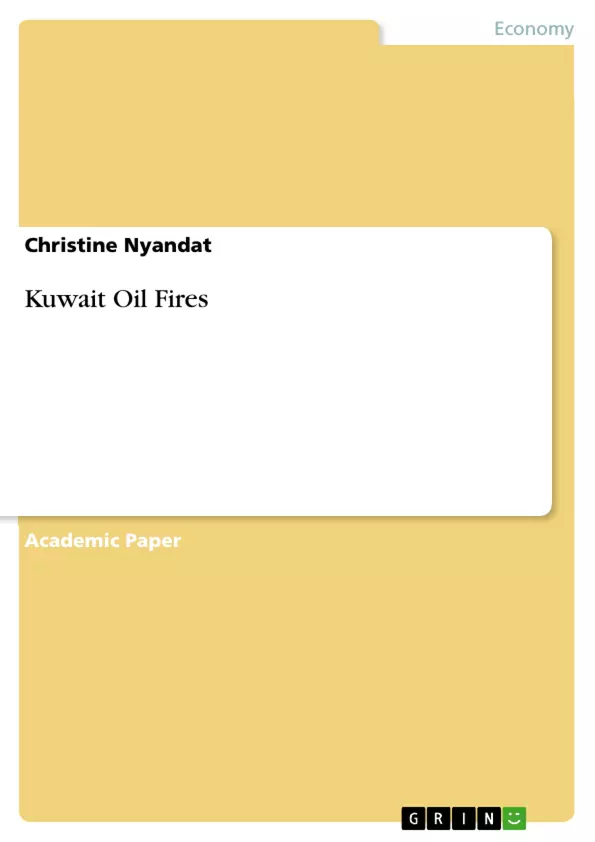Oil well flames allude to gas or oil wells that are consuming. Oil well flames can happen because of human activities, for example, illegal conflagration or mishaps, or regular occasions, for example, lightning. These flames cause ecological impacts and discharge lethal contaminations into the air, which result in wellbeing related issues. In this way, the Oil Flames were brought about by the Iraqi Military Powers, setting a flame to 605 to 732 Oil Wells. The flames were made in January and February 1991, and the principal Well flames were quenched in April 1991 and the keep going one on November 6, 1991. S There was a conflict amongst Iraq and Kuwait over some boring in oil. However, Kuwait was delivering oil over the cutoff points by the Association of the Oil Exporting Nations or only (OPEC) for short.
Table of Contents
- Kuwait Oil Fires
- Environmental Impact
- Impact on Marine Life and Resources
Objectives and Key Themes
This preview aims to provide a comprehensive overview of the text concerning the 1991 Kuwait oil fires, focusing on their causes, environmental consequences, and lasting impacts. The preview excludes the conclusion to avoid spoilers.
- The causes and extent of the 1991 Kuwait oil fires.
- The immediate and long-term environmental consequences of the fires.
- The impact on marine life and resources in the Persian Gulf.
- The effects on Kuwait's air and water quality.
- The long-term recovery process and ongoing challenges.
Chapter Summaries
Kuwait Oil Fires: This section details the deliberate ignition of Kuwaiti oil wells by Iraqi forces during the Gulf War. It describes the sheer scale of the destruction, with hundreds of wells ablaze, resulting in the burning of over a billion barrels of oil. The timeline of the fires, from their initial ignition to their eventual extinguishing, is meticulously outlined, highlighting the extensive damage to oil infrastructure and the immense environmental consequences that were to follow. The section also discusses the pre-existing tensions between Iraq and Kuwait regarding oil production quotas as a significant contributing factor leading up to the conflict and the deliberate destruction.
Environmental Impact: This section explores the devastating environmental impact of the oil fires. It details the massive release of pollutants into the atmosphere, including carbon monoxide, sulfur oxides, nitrogen oxides, and acidic aerosols. These pollutants contributed to ozone depletion, increased temperatures in Kuwait, acid rain, and ecosystem destruction. The text also describes the widespread soot accumulation and oil lakes that rendered large parts of the Kuwaiti desert uninhabitable. The role of prevailing winds in dispersing pollutants across the region and the resulting atmospheric inversions that trapped smoke are discussed, along with resulting sandstorms. The extensive and long lasting consequences are emphasized, detailing the challenges of recovery.
Impact on Marine Life and Resources: This section focuses on the severe effects of the oil fires and subsequent oil spills on marine life and resources in the Persian Gulf. It explains how the oil pollution disrupted fish and shrimp spawning, harming various species including green turtles, hawksbill turtles, whales, dolphins, sea snakes, migrating birds (like cormorants and flamingos), and dugongs. Specific examples are given, such as the death of indigenous cormorants due to exposure to polluted oil and air. The section also highlights the substantial reduction in fish harvests and the threat to freshwater supplies due to the damage to desalination plants. The long term impacts on the fishing industry and ecosystems are clearly illustrated.
Keywords
Kuwait oil fires, Gulf War, environmental damage, air pollution, water pollution, marine life, oil spills, ecosystem destruction, long-term consequences, recovery.
Frequently Asked Questions: Kuwait Oil Fires - A Comprehensive Overview
What is the purpose of this text preview?
This preview offers a comprehensive overview of the 1991 Kuwait oil fires, covering their causes, environmental consequences, and lasting impacts. It includes the table of contents, objectives, key themes, chapter summaries, and keywords, but excludes the conclusion.
What are the key themes explored in this text?
The key themes include the causes and extent of the 1991 Kuwait oil fires; the immediate and long-term environmental consequences; the impact on marine life and resources in the Persian Gulf; the effects on Kuwait's air and water quality; and the long-term recovery process and ongoing challenges.
What does the chapter on "Kuwait Oil Fires" cover?
This chapter details the deliberate ignition of Kuwaiti oil wells by Iraqi forces during the Gulf War, outlining the scale of destruction (hundreds of wells ablaze, over a billion barrels of oil burned), the timeline of the fires, and the damage to oil infrastructure. It also discusses pre-existing tensions between Iraq and Kuwait as a contributing factor.
What are the main points discussed in the "Environmental Impact" chapter?
This chapter explores the devastating environmental consequences, including the massive release of pollutants (carbon monoxide, sulfur oxides, etc.), ozone depletion, increased temperatures, acid rain, ecosystem destruction, widespread soot accumulation, oil lakes, the role of prevailing winds, atmospheric inversions, and the long-lasting challenges of recovery.
What is covered in the chapter on "Impact on Marine Life and Resources"?
This chapter focuses on the severe effects on marine life in the Persian Gulf. It details how oil pollution disrupted fish and shrimp spawning, harming various species (turtles, whales, dolphins, birds, etc.). It highlights the reduction in fish harvests, threats to freshwater supplies, and long-term impacts on the fishing industry and ecosystems.
What keywords are associated with this text?
Keywords include: Kuwait oil fires, Gulf War, environmental damage, air pollution, water pollution, marine life, oil spills, ecosystem destruction, long-term consequences, and recovery.
What topics are covered in the table of contents?
The table of contents includes: Kuwait Oil Fires, Environmental Impact, and Impact on Marine Life and Resources.
- Arbeit zitieren
- Christine Nyandat (Autor:in), 2020, Kuwait Oil Fires, München, GRIN Verlag, https://www.hausarbeiten.de/document/922965


